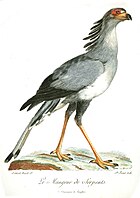| Circaetus | |
|---|---|
 | |
| Short-toed snake eagle (Circaetus gallicus) | |
| Scientific classification | |
| Domain: | Eukaryota |
| Kingdom: | Animalia |
| Phylum: | Chordata |
| Class: | Aves |
| Order: | Accipitriformes |
| Family: | Accipitridae |
| Subfamily: | Circaetinae |
| Genus: | Circaetus Vieillot, 1816 |
| Type species | |
| Falco gallicus Gmelin, 1788 | |
Circaetus, the snake eagles, is a genus of medium-sized eagles in the bird of prey family Accipitridae. They are mainly resident African species, but the migratory short-toed snake eagle breeds from the Mediterranean basin into Russia, the Middle East and India, and winters in sub-Saharan Africa and east to Indonesia.
Contents
Snake eagles are found in open habitats like cultivated plains arid savanna, but require trees in which to build a stick nest. The single egg is incubated mainly or entirely by the female.
Circaetus eagles have a rounded head and broad wings. They prey on reptiles, mainly snakes, but also take lizards and occasionally small mammals.









